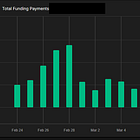The Hidden Secret to Position Sizing: Only Allow Exposures You Want - Research Article #65
A practical guide to the powerful 4S method with examples for anyone.
👋 Hey there, Pedma here! Welcome to the 🔒 exclusive subscriber edition 🔒 of Trading Research Hub’s Newsletter. Each week, I release a new research article with a trading strategy, its code, and much more.
If you’re not a subscriber, here’s what you missed this past month so far:
If you’re not yet a part of our community, subscribe to stay updated with these more of these posts, and to access all our content.
How much money do I allocate to a position, in a portfolio that trades different assets, with completely different risk profiles?
Let’s say that we are trading or investing in U.S. equities, Bitcoin and Altcoins.
Is there a systematic approach that provides us with a solution to this problem?
There is.
Back in 2021, when I was starting to get a bit more serious about my trading in the crypto sector, I was also trading U.S. equities at the same time.
But I quickly realized that I made a lot of money when crypto was up, and lost a lot of money when crypto was down. Being up or down on equities was irrelevant.
The problem was not that equities have lower returns, even though that is true on an absolute basis. The problem was that I was distributing my capital equally, amongst 2 markets with completely different volatility profiles!
In the picture below, I picked 2 random altcoins, added BTC and S&P500, and compared their different volatility profiles.
As we can see, DOGE is an altcoin with almost 6x the volatility of the S&P500. This means that if we trade them together, in the same portfolio, and we give them an equally sized position to hold or trade, the S&P portion of our portfolio will be almost irrelevant, just due to the sheer contribution of DOGE volatility to our equity.
This is not right.
We don’t want to be too exposed to one asset’s performance over the other. Otherwise if we do, we are making an implicit assumption that we believe that one asset is better than the other. And I don’t think that’s what we want to do.
Today, we solve that problem.
But first, let’s talk about something that most retail traders have somewhat of a misconception about.
If you’re interested in 1-1 consulting with me, I am opening a few spots this year to help traders increase their likelihood of achieving profitability in the markets. If you’re interested, book a free call and ask me any questions: https://cal.com/pedma/15min





